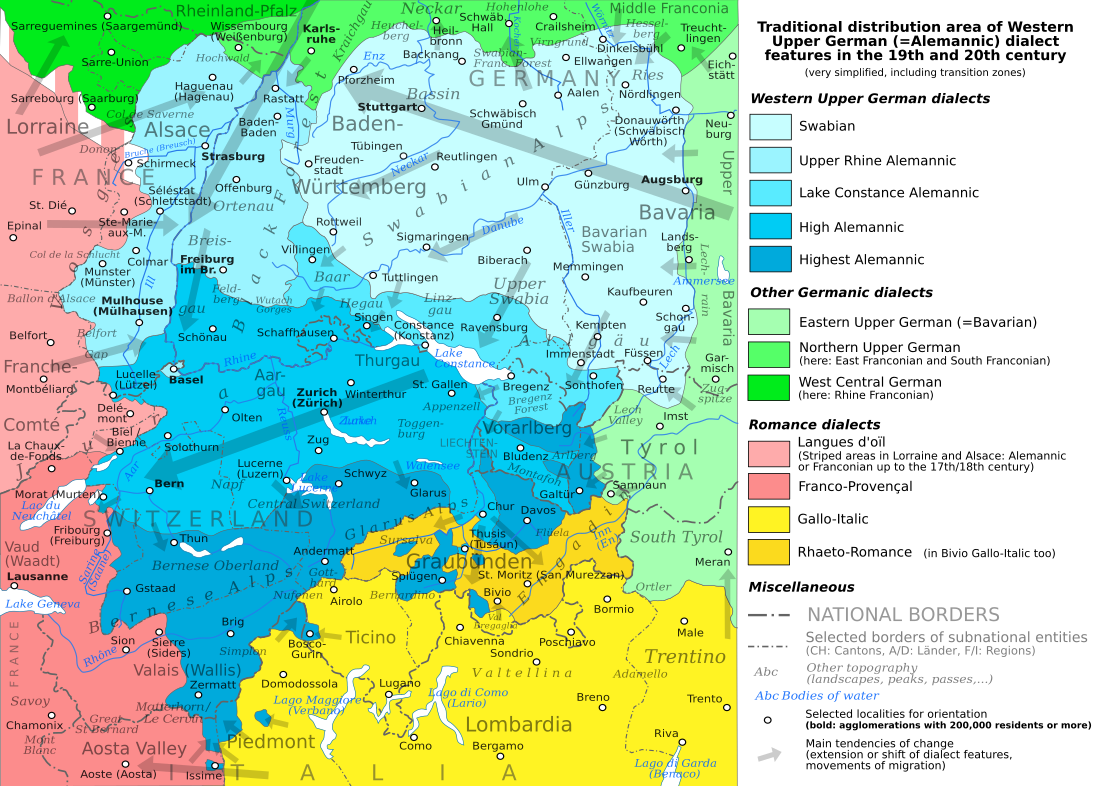Top Qs
Timeline
Chat
Perspective
Low Alemannic German
Northern branch of Alemannic in western Germany From Wikipedia, the free encyclopedia
Remove ads
Low Alemannic German (German: Niederalemannisch) is a branch of Alemannic German, which is part of Upper German. Its varieties are only partly intelligible to non-Alemannic speakers.
This article needs additional citations for verification. (May 2012) |
Remove ads
Subdivisions
- Lake Constance Alemannic (de)
- Northern Vorarlberg (de)
- Allgäu dialect (de)
- Baar dialect
- Southern Württemberg
- Upper Rhenish Alemannic (de)
- Basel German
- Baden dialects north of Markgräflerland
- Alsatian, spoken in Alsace, in some villages of the Phalsbourg county in Lorraine and by some Amish in Indiana
- Low Alemannic dialects in the Black Forest[2]
- Colonia Tovar dialect, Venezuela
Features
The feature that distinguishes Low Alemannic from High Alemannic is the retention of Germanic /k/, for instance kalt 'cold' vs. High Alemannic chalt.[citation needed]
The feature that distinguishes Low Alemannic from Swabian is the retention of the Middle High German monophthongs, for instance Huus 'house' vs. Swabian Hous or Ziit 'time' vs. Swabian Zejt.[citation needed]
Phonology
Summarize
Perspective
Consonants
Voiced obstruents do not occur, as is typical for Upper German dialects.
¹/x/ is palatalized as [ç] after front vowels in the northern varieties (like in Standard German) but kept as [x] in southern varieties. Diverging from Standard German /x/ is not palatalized after /r/, a feature shared with other alemannic varieties.
²/r/ is most commonly pronounced as [ʁ].
³ /pʰ/ and /tʰ/ don't occur in autochthonous vocabulary but are used by speakers in differing frequency when using words from Standard German or speaking in more formal registers.
Vowels
Remove ads
Orthography
There exists no official orthography and authors use different kinds of orthographies for their work.
(All of the below is specific to the dialects spoken near Freiburg im Breisgau)
Vowels:
Consonants:
Are as in Standard German, with the following notes:
- kh is an aspirated [kʰ]
- ng is a velar nasal [ŋ]
- ngg is a velar nasal followed by a velar plosive [ŋɡ]
- ph is an aspirated [pʰ]
- th is an aspirated [tʰ]
- s is always voiceless [s] or [z̥]
- b, d and g are voiceless [b̥], [d̥] and [g̊].
Remove ads
Articles
Definite Article
Indefinite Article
Remove ads
Substantives
Plurals
- Class I: Plural = Singular (e.g. Ääber → Ääber)
- Class II: Plural = Singular + Umlaut (e.g. Baum → Baim; Vader → Väder)
- Class IIIa: Plural = Singular + -e (e.g. Man → Mane; Ags → Agse)
- Class IIIb: Plural = Singular + -̈e (e.g. Frosch → Fresche)
- Class IVa: Plural = Singular + -er (e.g. Lyyb → Lyyber; Schùg → Schùger)
- Class IVb: Plural = Singular + -̈er (e.g. Wald → Wälder; Blad → Bleder)
- Class V: No Plural (e.g. Chees; Zemänd)
- Class VI: No Singular (Plural Only) (e.g. Bilger; Fèèrine)
Diminutives
- Standard ending is -li (e.g. Aimer → Aimerli)
- If the word ends in -l, then the ending is -eli (e.g. Dääl → Dääleli)
- If the word ends in -el, then the ending is -i (e.g. Degel → Degeli)
- If the word ends in -e, remove the -e and add -li (e.g. Bèère → Bèèrli)
- The rules for this can be quite complex and depend on the region. Sometimes diminutives require umlaut, other times not.
Remove ads
Adjectives
Weak Declension
Strong Declension
Comparative
- Standard ending -er (e.g. fèin → fèiner)
Superlative
- Standard ending -(e)schd (e.g. fèin → fèinschd)
Irregular
Remove ads
Pronouns
Personal Pronouns
Remove ads
Verbs
Summarize
Perspective
1. Infinitive
Infinitive ends in -e
- Some monosyllabic verbs do not have this ending (e.g. chùù, döe, goo, gschää, haa, loo, nee, sää, schdoo, schlaa, syy, zie, etc.)
2. Participle
2.1 Prefix
- The prefix for g- or ge-
- Before b, d, g, bf, dsch, and z is merged into the word and not visible (e.g. broochd, glaubd, etc.)
2.2 Suffix
- Strong Verbs end in -e (e.g. gäse, glofe)
- Weak Verbs end in -d or -ed (e.g. bùzd, gchaufd)
2.3 Types
2.3.1 Infinitive and Present Sg y/èi/ai - Participle i
2.3.1.1 y > i (e.g. abwyyse > abgwiise)
2.3.1.2 èi > i (e.g. verzèie > verziie)
2.3.1.3 ai > i (e.g. schaide > gschiide)
2.3.2 Infinitive and Present Sg ie/u/au/èi/i - Participle o/öu/öe
2.3.2.1 ie > o (e.g. biede > bode)
2.3.2.2 u > o (e.g. sufe > gsofe)
2.3.2.3 au > o (e.g. laufe > glofe)
2.3.2.4 èi > öu (e.g. rèie > gröue)
2.3.2.5 ie > öe (e.g. riefe > gröefe)
2.3.2.5 i > o (e.g. wiige > gwooge)
2.3.3 Infinitive and Present Sg i - Participle ù
2.3.3.1 i > u (e.g. binde > bùnde)
2.3.4 Infinitive ä/e - Present i - Participle o/u
2.3.4.1 ä - i - o (e.g. bräche > broche)
2.3.4.2 ä - i - u (e.g. hälfe > ghùlfe)
2.3.4.3 e/è - i - o (e.g. verdèèrbe > verdoorbe)
2.3.4.4 e - i - ù (e.g. schmelze > gschmùlze)
2.3.5 Infinitive ä/i - Present i - Participle ä
2.3.5.1 ä - i - ä (e.g. äse > gäse)
2.3.5.2 i - i - ä (e.g. bide > bäde)
2.3.6 Infinitive Vowel is the same as the Participle
2.3.5.1 (e.g. bache > bache; fale > gfale)
3. Conjugation
3.1 Present Tense
3.1.1 Regular Verb
Numbers
Remove ads
References
Wikiwand - on
Seamless Wikipedia browsing. On steroids.
Remove ads

